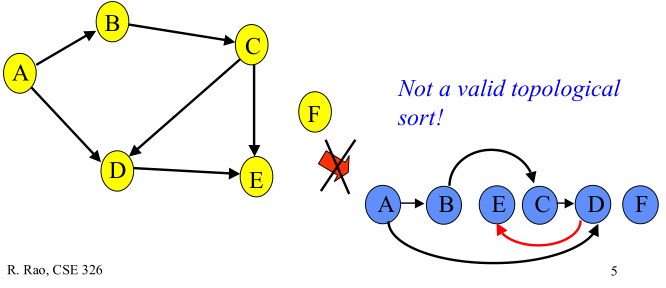【图论】有向无环图的拓扑排序
来源:互联网 发布:c语言左移和右移 编辑:程序博客网 时间:2024/05/21 17:11
【图论】有向无环图的拓扑排序
1. 引言
有向无环图(Directed Acyclic Graph, DAG)是有向图的一种,字面意思的理解就是图中没有环。常常被用来表示事件之间的驱动依赖关系,管理任务之间的调度。拓扑排序是对DAG的顶点进行排序,使得对每一条有向边(u, v),均有u(在排序记录中)比v先出现。亦可理解为对某点v而言,只有当v的所有源点均出现了,v才能出现。
下图给出有向无环图的拓扑排序:

下图给出的顶点排序不是拓扑排序,因为顶点D的邻接点E比其先出现:

2. 算法原理与实现
拓扑排序的实现算法有两种:入度表、DFS,其时间复杂度均为





入度表
对于DAG的拓扑排序,显而易见的办法:
- 找出图中0入度的顶点;
- 依次在图中删除这些顶点,删除后再找出0入度的顶点;
- 然后再删除……再找出……
- 直至删除所有顶点,即完成拓扑排序
为了保存0入度的顶点,我们采用数据结构栈(亦可用队列);算法的可视化可参看这里。
图用邻接表(adjacency list)表示,用数组inDegreeArray[]记录结点的入度变化情况。C实现:
// get in-degree arrayint *getInDegree(Graph *g) { int *inDegreeArray = (int *) malloc(g->V * sizeof(int)); memset(inDegreeArray, 0, g->V * sizeof(int)); int i; AdjListNode *pCrawl; for(i = 0; i < g->V; i++) { pCrawl = g->array[i].head; while(pCrawl) { inDegreeArray[pCrawl->dest]++; pCrawl = pCrawl->next; } } return inDegreeArray;}// topological sort functionvoid topologicalSort(Graph *g) { int *inDegreeArray = getInDegree(g); Stack *zeroInDegree = initStack(); int i; for(i = 0; i < g->V; i++) { if(inDegreeArray[i] == 0) push(i, zeroInDegree); } printf("topological sorted order\n"); AdjListNode *pCrawl; while(!isEmpty(zeroInDegree)) { i = pop(zeroInDegree); printf("vertex %d\n", i); pCrawl = g->array[i].head; while(pCrawl) { inDegreeArray[pCrawl->dest]--; if(inDegreeArray[pCrawl->dest] == 0) push(pCrawl->dest, zeroInDegree); pCrawl = pCrawl->next; } }}时间复杂度:得到inDegreeArray[]数组的复杂度为



















DFS
在DFS中,依次打印所遍历到的顶点;而在拓扑排序时,顶点必须比其邻接点先出现。在下图中,顶点5比顶点0先出现,顶点4比顶点1先出现。

在DFS实现拓扑排序时,用栈来保存拓扑排序的顶点序列;并且保证在某顶点入栈前,其所有邻接点已入栈。DFS版拓扑排序的可视化参看这里。
C实现:
/* recursive DFS function to traverse the graph,* the graph is represented by adjacency list*/void dfs(int u, Graph *g, int *visit, Stack *s) { visit[u] = 1; AdjListNode *pCrawl = g->array[u].head; while(pCrawl) { if(!visit[pCrawl->dest]) dfs(pCrawl->dest, g, visit, s); pCrawl = pCrawl->next; } push(u, s);}// the topological sort functionvoid topologicalSort(Graph *g) { int *visit = (int *) malloc(g->V * sizeof(int)); memset(visit, 0, g->V * sizeof(int)); Stack *s = initStack(); int i; for(i = 0; i < g->V; i++) { if(!visit[i]) dfs(i, g, visit, s); } // the order of stack element is the sorted order while(!isEmpty(s)) { printf("vertex %d\n", pop(s)); }}时间复杂度:应与DFS相同,为





完整代码在Github。
3. 参考资料
[1] R. Rao, Lecture 20: Topo-Sort and Dijkstra’s Greedy Idea.
[2] GeeksforGeeks, Topological Sorting.
[3] GeeksforGeeks, Graph and its representations.
- 【图论】有向无环图的拓扑排序
- 有向无环图的拓扑排序
- 有向无环图的拓扑排序
- 有向无环图的拓扑排序
- 图论-有向图的拓扑排序
- 有向无环图(DAG)拓扑排序的两种方法
- 有向无环图的单源最短路径----拓扑排序+松弛
- 拓扑排序+有向无环图(DAG)的检测
- 算法: 有向无环图(DAG)的拓扑排序
- 有向无环图(DAG)拓扑排序的两种方法
- C语言实现有向无环图的拓扑排序算法
- 有向图的拓扑排序
- 有向图的拓扑排序
- 有向图的拓扑排序C++
- 有向图的拓扑排序
- 有向图的拓扑排序~TopologicalSort
- 有向图的拓扑排序
- 有向图的拓扑排序
- [YTU](3019)螺旋方阵
- oracle排序
- Hibernate一对一注解,一对多注解
- 好好准备找工作
- this关键字的应用
- 【图论】有向无环图的拓扑排序
- 前端之ajax解析
- Double Patience UVA
- Caffe_Windows学习笔记(七)细粒度图像分类
- continue和break
- 类与对象第五题
- 输出一个某种编码的字符串
- 2017 乌鲁木齐赛区网络赛 Coconut(【模拟题目】)
- 209. Minimum Size Subarray Sum解题报告


